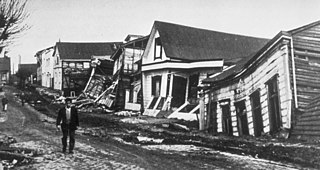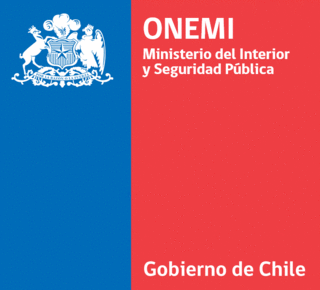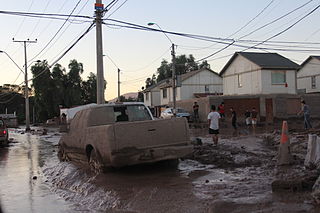Related Research Articles

The 1960 Valdivia earthquake and tsunami or the Great Chilean earthquake on 22 May 1960 was the most powerful earthquake ever recorded. Most studies have placed it at 9.4–9.6 on the moment magnitude scale, while some studies have placed the magnitude lower than 9.4. It occurred in the afternoon, and lasted 10 minutes. The resulting tsunamis affected southern Chile, Hawaii, Japan, the Philippines, eastern New Zealand, southeast Australia, and the Aleutian Islands.

Villarrica is one of Chile's most active volcanoes, rising above the lake and town of the same name, 750 km (470 mi) south of Santiago. It is also known as Rucapillán, a Mapuche word meaning "great spirit's house" or " the demon's house". It is the westernmost of three large stratovolcanoes that trend northwest to southeast obliquely perpendicular to the Andean chain along the Mocha-Villarrica Fault Zone, and along with Quetrupillán and the Chilean portion of Lanín, are protected within Villarrica National Park. Guided ascents are popular during summer months.

The 2007 Aysén Fjord earthquakes occurred in Aisén Fjord, Chile from January 22 – April 22. The biggest occurred at 1:53 p.m. on April 21 and reached a felt intensity of VII on the Mercalli intensity scale. On the moment magnitude scale, the earthquake reached a magnitude of 6.2. Ten people disappeared due to a tsunami caused by a landslide, according to ONEMI, but three bodies were found on April 22 by the Chilean Navy.

Chaitén is a volcanic caldera 3 kilometres (2 mi) in diameter, 17 kilometres (11 mi) west of the elongated ice-capped Michinmahuida volcano and 10 kilometres (6 mi) northeast of the town of Chaitén, near the Gulf of Corcovado in southern Chile. The most recent eruptive phase of the volcano erupted on 2008. Originally, radiocarbon dating of older tephra from the volcano suggested that its last previous eruption was in 7420 BC ± 75 years. However, recent studies have found that the volcano is more active than thought. According to the Global Volcanism Program, its last eruption was in 2011.

The Atacama Desert is a desert plateau located on the Pacific coast of South America, in the north of Chile. Stretching over a 1,600-kilometre-long (1,000-mile) strip of land west of the Andes Mountains, it covers an area of 105,000 km2 (41,000 sq mi), which increases to 128,000 km2 (49,000 sq mi) if the barren lower slopes of the Andes are included.

ONEMI or National Office of Emergency of the Interior Ministry was a Chilean government agency dedicated to the prevention, organization, coordination and information relative to natural disasters. After the 1960 Valdivia earthquake a committee was formed to solve problems caused by the earthquake. However, this committee was not dissolved afterwards and in 1974, it acquired by law independent status as governmental office.

The 2011–2012 Puyehue-Cordón Caulle eruption was a volcanic eruption that began in the Puyehue-Cordón Caulle volcanic complex in Chile on 4 June 2011. The eruption, which occurred from the Cordón Caulle fissure after 51 years of the volcano being inactive, is one of the largest volcanic eruptions of the 21st century thus far. At least 3,500 people were evacuated from nearby areas, while the ash cloud was blown across cities all around the Southern hemisphere, including Bariloche, Buenos Aires, Montevideo, Stanley, Porto Alegre, Cape Town, Hobart, Perth, Adelaide, Sydney, Melbourne, Wellington, Auckland and Port Moresby, forcing airlines to cancel hundreds of international and domestic flights and causing travel chaos.

The 2010 Pichilemu earthquakes, also known as the Libertador O'Higgins earthquakes, were a pair of intraplate earthquakes measuring 6.9 and 7.0 Mw that struck Chile's O'Higgins Region on 11 March 2010 about 16 minutes apart. The earthquakes were centred 15 kilometres (9.3 mi) northwest of the city of Pichilemu.
The Great Fire of Valparaíso started on 12 April 2014 at 16:40 local time, in the hills of the city of Valparaíso, Chile. The wildfire destroyed at least 2,500 homes, leaving 11,000 people homeless. An additional 6,000 people were evacuated from the city, which was placed on red alert and declared a disaster zone. Fifteen people were confirmed killed and ten suffered serious injuries.
The following lists events that happened during 2002 in Chile.

The 2015 Northern Chile floods were a series of mudflows that affected much of northern Chile, product of flash floods from different rivers due to unseasonal heavy rains in the area, causing severe damage in several towns of the Antofagasta, Atacama and Coquimbo regions. Flooding in Chile and Peru resulted from an unusual cold front which moved across the Andes, bringing heavy rainfall to the region.

The 2015 Illapel earthquake occurred 46 km (29 mi) offshore from Illapel on September 16 at 19:54:32 Chile Standard Time (22:54:32 UTC), with a moment magnitude of 8.3–8.4. The initial quake lasted between three and five minutes; it was followed by several aftershocks greater than magnitude six and two that exceeded 7.0 moment magnitude. The Chilean government reported 15 deaths, 6 missing and thousands of people affected. In Buenos Aires, Argentina, a man died from a stroke while he was evacuating a building.

From December 2016 and continuing until May 2017, much of western and central South America was plagued by persistent heavy rain events. In Peru, one of the most severely impacted nations, it has been referred to as the 2017 Coastal Niño. The flooding was preceded by drought-like conditions throughout the region for much of 2016 and a strong warming of sea temperatures off the coast of Peru.

A series of mudflows occurred in Southern California in early January 2018, particularly affecting areas northwest of Montecito in Santa Barbara County. The incident was responsible for 23 deaths, although the body of one of the victims has never been found. Approximately 163 people were hospitalized with various injuries, including four in critical condition. The disaster occurred one month after a series of major wildfires. The conflagrations devastated steep slopes, which caused loss of vegetation and destabilization of the soil and greatly facilitated subsequent mudflows. The mudflows caused at least $177 million in property damage, and cost at least $7 million in emergency responses and another $43 million to clean up.
On August 28, 2004, following heavy rainfall, mudflows overran several houses in near Futrono, southern Chile. Chile Route T-55 between Futrono and Llifén was cut off by the landslide. At least three separate mudflows occurred in the event.
The Villa Santa Lucía mudflow was a natural disaster in Chaitén commune, southern Chile, that occurred on the morning of December 16, 2017, in the namesake locality, located in the commune of Chaitén, Los Lagos Region. The mudflow caused the death of 21 persons and the disappearance of one.
The July 2011 Chilean winter storm was a winter storm affecting the Andean portions of Biobío, including Ñuble Province, and Araucanía regions in south-central Chile. Through the Andean valleys thousands of people were left isolated because of heavy snowfall. In some sectors, blackouts occurred. Avalanches left the tourist facilities of Termas de Chillán isolated. There was a loss of livestock, mainly sheep as a consequence of the storm. On the night of July 19, temperatures as low as −18 °C (0 °F) were reported in Liucura.
The 1991 Antofagasta mudflow was a natural disaster in the city of Antofagasta, northern Chile, that occurred on the morning of June 18, 1991. The mudflow was triggered by an unusual rainfall of 42 mm during the night. Mudflows also affected the port of Taltal 180 km south of Antofagasta. 91 persons are confirmed to have died in the disaster and the whereabouts of an additional 19 have never been clarified. About 700 houses were either destroyed or damaged beyond repairs. In Antofagasta the mudflows from the quebradas of La Cadena, Salar del Carmen, Baquedano and El Ancla were the most destructive. Other quebradas were less destructive mudflows developed were Huáscar, Jardines del Sur, Universidad de Antofagasta, Las Vertientes, Caliche, El Toro, Uribe, Riquelme, Farellones, Bonilla Norte, Bonilla Sur, Club Hípico and La Chimba.

The 2019 Coquimbo earthquake occurred 10 km south southwest of Coquimbo in Chile, on January 19, 2019 at 22:32. The epicenter was located off the coast of the Coquimbo Region at a depth of 63.0 km,) and had a moment magnitude of 6.7. On the Mercalli scale, the earthquake reached an intensity of VIII.
References
- 1 2 "Aluvión en Los Molles dejó tres muertos, dos desaparecidos y más de 625 damnificados". Cooperativa (in Spanish). June 3, 2002. Retrieved January 20, 2019.
- 1 2 3 4 Sistema frontal norte, centro y sur 2-5 junio 2002 (PDF) (Report). Consolidado (in Spanish). ONEMI. 2009. p. 35. Retrieved January 25, 2019.